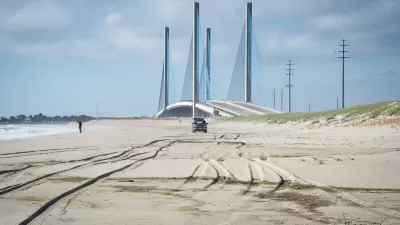As the destructive force of Hurricane Sandy demonstrated, all sand dunes are not created equal. But as coastal communities start to rebuild their defenses for the next storm, they're trying to close the gap with Mother Nature.
Hurricane Sandy made the value of natural defenses much more apparent to coastal communities throughout the Northeast. According to Katie Barnett, a specialist with the New Jersey Department of Environmental Protection, "The areas that had natural stable dune systems are the areas that survived the best. The areas that didn't have dune systems are the areas that really got wiped out."
Adam Cole looks at the ways that scientists and officials like Barnett are trying to improve the strength of man-made dunes. Take old Christmas Trees, for example. "The trees' needles and branches will trap windborne sand and serve as a foundation for new dunes." However, notes Cole, "[p]iles of sand — even those anchored by Christmas trees — will erode much faster than natural dunes."
"Natural dunes are strong, but they take a long time to grow."
"I would say ... a decade," says Norbert Psuty, a retired professor from Rutgers University.
"You might have to wait until 2023 for your dune system to fully recover from Sandy," adds Cole. But, "Island Beach State Park Manager Ray Bukowski says they don't have that kind of time."
"We can't sit and hope a dune gets re-formed here," Bukowski says. "We've got to jump-start the dune and let it start doing its thing."
FULL STORY: After Sandy, Not All Sand Dunes Are Created Equal

Study: Maui’s Plan to Convert Vacation Rentals to Long-Term Housing Could Cause Nearly $1 Billion Economic Loss
The plan would reduce visitor accommodation by 25,% resulting in 1,900 jobs lost.

North Texas Transit Leaders Tout Benefits of TOD for Growing Region
At a summit focused on transit-oriented development, policymakers discussed how North Texas’ expanded light rail system can serve as a tool for economic growth.

Why Should We Subsidize Public Transportation?
Many public transit agencies face financial stress due to rising costs, declining fare revenue, and declining subsidies. Transit advocates must provide a strong business case for increasing public transit funding.

How to Make US Trains Faster
Changes to boarding platforms and a switch to electric trains could improve U.S. passenger rail service without the added cost of high-speed rail.

Columbia’s Revitalized ‘Loop’ Is a Hub for Local Entrepreneurs
A focus on small businesses is helping a commercial corridor in Columbia, Missouri thrive.

Invasive Insect Threatens Minnesota’s Ash Forests
The Emerald Ash Borer is a rapidly spreading invasive pest threatening Minnesota’s ash trees, and homeowners are encouraged to plant diverse replacement species, avoid moving ash firewood, and monitor for signs of infestation.
Urban Design for Planners 1: Software Tools
This six-course series explores essential urban design concepts using open source software and equips planners with the tools they need to participate fully in the urban design process.
Planning for Universal Design
Learn the tools for implementing Universal Design in planning regulations.
City of Santa Clarita
Ascent Environmental
Institute for Housing and Urban Development Studies (IHS)
City of Grandview
Harvard GSD Executive Education
Toledo-Lucas County Plan Commissions
Salt Lake City
NYU Wagner Graduate School of Public Service




























